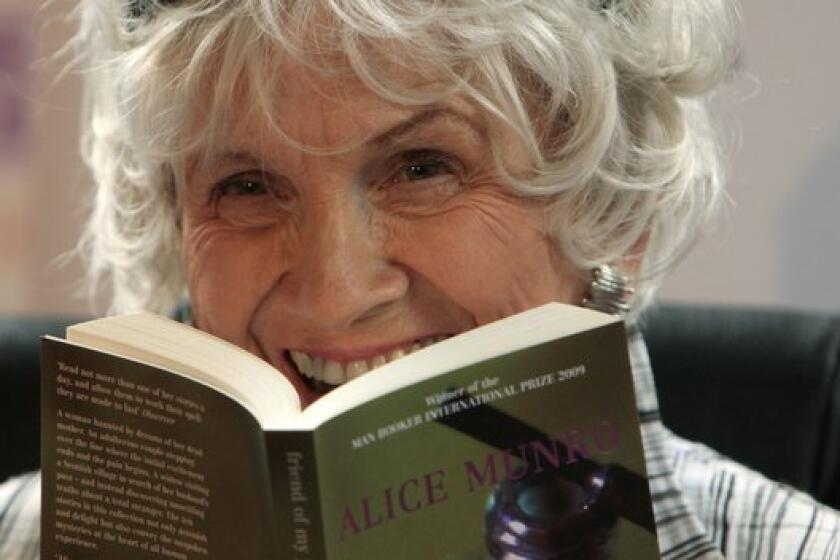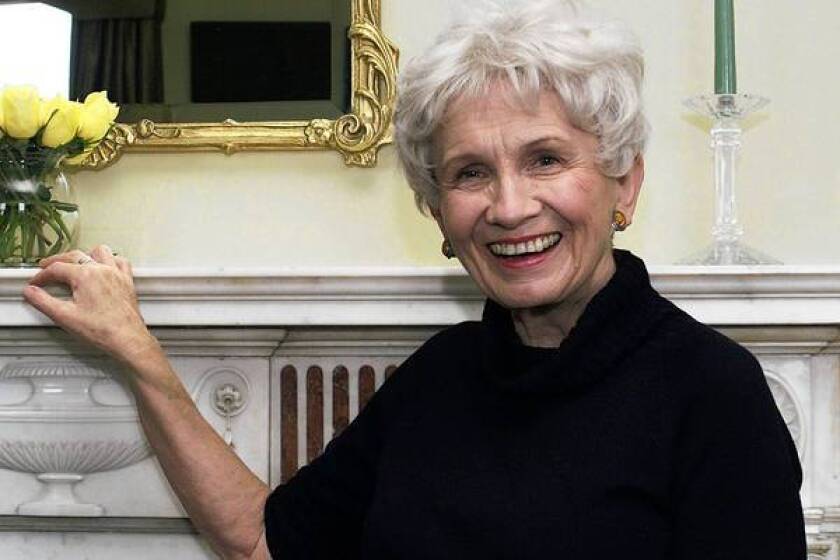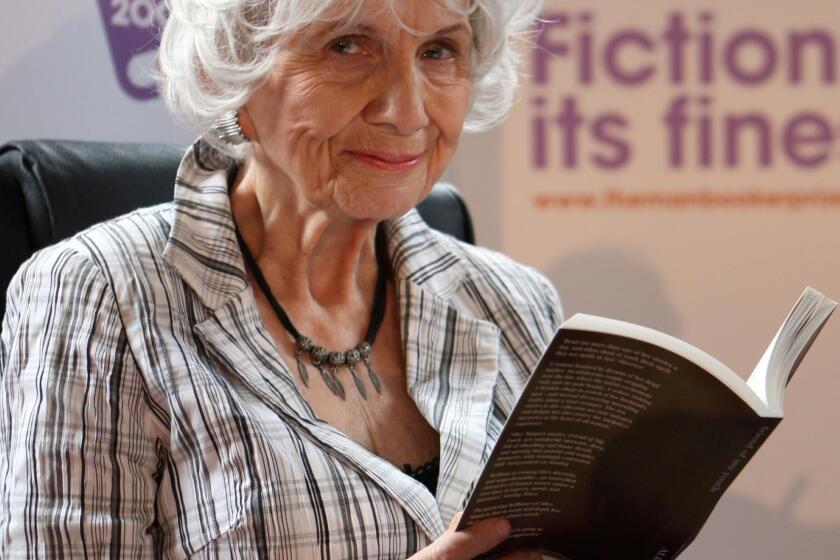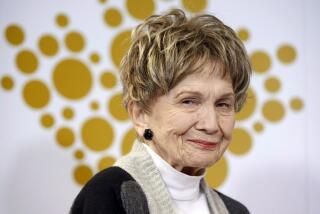Alice Munro, acclaimed short-story writer and Nobel Prize winner, dies at 92
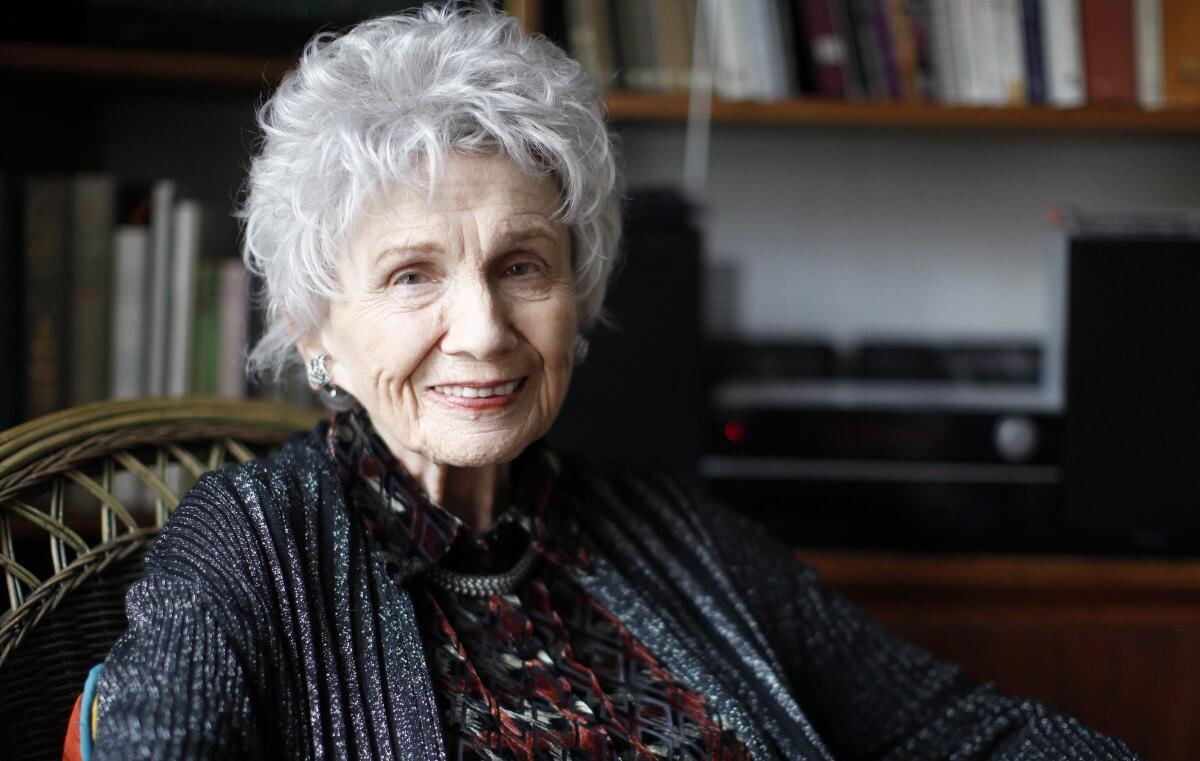
Alice Munro, the Canadian short story writer who lent mythic proportions to the lives of ordinary people from small, rural towns like those in the Ontario countryside where she spent most of her life, has died. She was 92.
The authorâs publisher, Penguin Random House Canada, confirmed on its website Munro died Monday evening at her home in Port Hope, Ontario. A cause of death was not revealed, though the author had been in frail health since undergoing heart surgery in 2001.
Kristin Cochrane, the chief executive of Penguin Random House Canada, paid tribute to Munro in a statement published on the website. âAlice Munro is a national treasure â a writer of enormous depth, empathy, and humanity whose work is read, admired, and cherished by readers throughout Canada and around the world,â Cochrane said.
The statement continued: âAliceâs writing inspired countless writers too, and her work leaves an indelible mark on our literary landscape. All of us at Penguin Random House Canada mourn this loss and we join together with our colleagues at Penguin Random House in the U.S., the U.K., and globally in appreciation for all that Alice Munro has left behind.â
Considered by many to be the finest short fiction writer of her generation, Munro was awarded the Nobel Prize in literature in 2013, only months after publishing a collection of stories that she said would be her last. She had already received the Man Booker International Prize, the National Book Critics Circle Award in the United States and every top literary prize offered in her native Canada, including its most prestigious, the Governor Generalâs Award.
Alice Munro, who won the Nobel Prize in Literature on Thursday, lives a quiet life in a small town in Ontario, Canada.
âAlice Munro is our Chekhov, and is going to outlast most of her contemporaries,â author Cynthia Ozick said some years ago, comparing her to Russiaâs 19th century master of the short story. Reviewers often linked the two writersâ names, partly because both had mastered a subtle peeling back of layers to reveal their characters.
Munro wrote about country folk who knew how to gut a turkey, breed foxes and sell medicine door to door, but also knew about unreliable love, family violence and failed attempts at social climbing. Her stories unfold, often in the fictional towns of Jubilee or Hanratty, with a direct simplicity paired with painstaking craftsmanship. She made no secret of the dozens of drafts it took her to complete a story.
âSheâs become a virtuoso,â author John Updike, the literary critic for the New Yorker, said in a 2001 interview with the Montreal Gazette. âShe manages to get into peopleâs skin without seeming to dive in, without being ostentatious.â
Several of Munroâs collections were made of linked stories where characters leap across years or decades before the last page. In âLives of Girls and Womenâ (1971), she identified some of her favorite kind of women. They were âdull, simple, amazing and unfathomable â deep caves paved with kitchen linoleum.â
News that Alice Munro, 82, was the winner of the 2013 Nobel Prize in Literature was met with tremendous enthusiasm from her fans in America.
She once explained her attraction to such lives, saying they only appear to be dull. âThe complexity of things, the things within things, just seems to be endless,â Munro said. âI mean, nothing is easy, nothing is simple.â
Her best works compare with classic tragedy written in prose form.
âI want to tell a story in the old-fashioned way â what happens to somebody,â Munro said in a 1998 Vintage Books interview. âBut I want the reader to feel something is astonishing. Not the âwhat happensâ but the way everything happens.â
There arenât many happy endings in Munro stories. But there is basic goodness, clearly exposed, in nearly all of her characters. If they lose, they usually lose in love, and carry their disappointments with quiet dignity.
The Nobel laureate in literature imparts the invaluable lesson of how to be in the moment as a writer.
âThe bleakness of its vision is enriched by the authorâs exquisite eye and ear for detail,â Joyce Carol Oates wrote in the New York Times in 1986. âLife is heartbreak, but it is also uncharted moments of kindness and reconciliation.â
Munro attracted international attention without ever leaving home. She lived most of her life in rural Ontario, surrounded by woods and farmland. She noted in interviews that she was raised on the wrong side of the tracks in her hometown of Wingham. As a young girl she could hardly wait to get away from that life, but years of writing fiction set in small towns changed her view.
âI am at home with the brick houses, the falling-down barns, the occasional farms that have swimming pools and airplanes, the trailer parks, burdensome old churches, Wal-Mart, and Canadian Tire,â Munro wrote in the introduction to âSelected Storiesâ (1996). âI speak the language.â
She vaulted into the mainstream by sheer force of will. Increasingly she was included in the lofty league with her friend Margaret Atwood as well as Carol Shields and Timothy Findley, Canadaâs leading fiction writers among her contemporaries.
She referred to herself as compulsive and driven about her work. She wrote every day and set the highest goals. As a beginner in the early 1950s she submitted her work to the New Yorker and was rejected again and again. Her first story for the magazine was published in 1979. After that she became a frequent contributor.
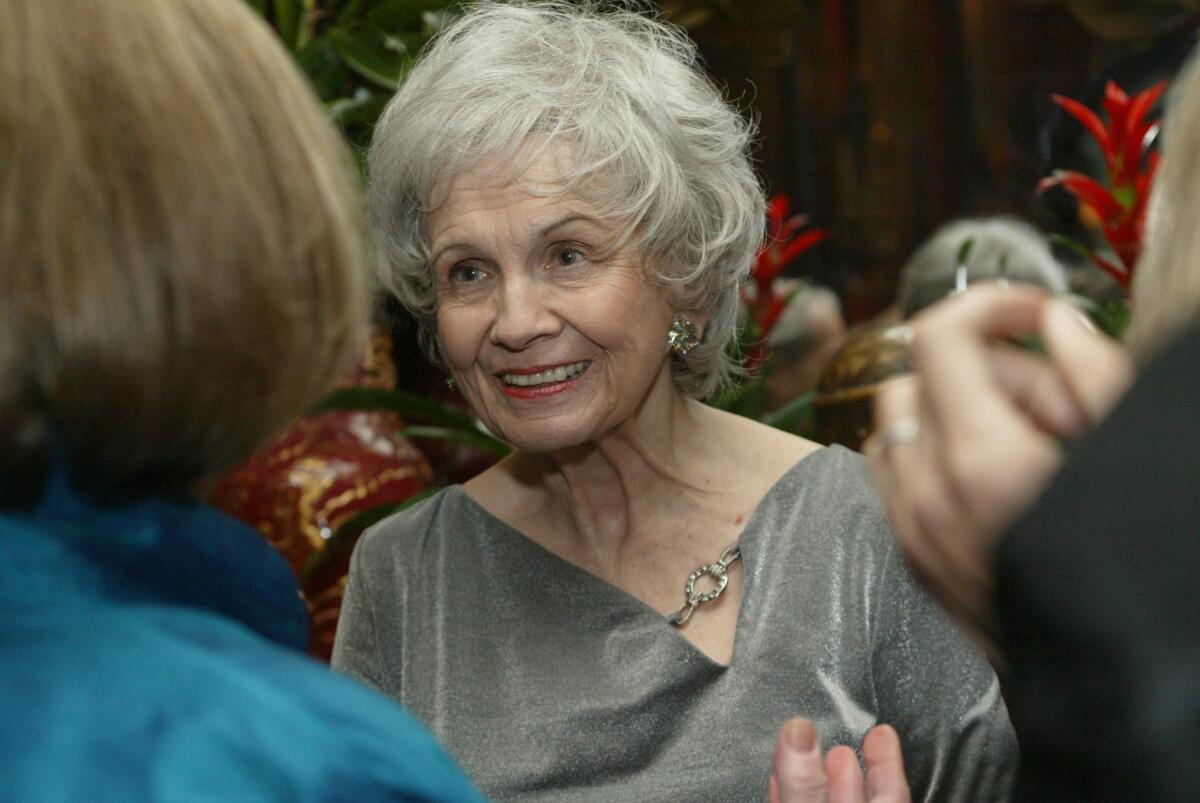
Daniel Menaker, who was Munroâs editor at the New Yorker and later the editor in chief at Random House, referred to her as âa modern and experimental writer in the clothing of a classical writer.â
âYou get the feeling sheâs trying to help you get at some true emotional psychological insight,â Menaker said in a 2003 interview with the Guardian. As often as not, he said, it leads to âa dark existential uncertainty about what makes people tick.â
Born Alice Laidlaw on July 10, 1931, and raised on a fox and mink farm, a failing family business, Munro was the oldest of three children. Her mother, Anne, was a stickler for âpureâ and ladylike behavior, which cramped Aliceâs imagination.
Anne Laidlaw developed Parkinsonâs disease when Alice was 10. Long-term illness only made their strained relationship worse. Alice left home at 17, torn by guilt, and did not return home during the last two years of her motherâs life.
In âThe Peace of Utrechtâ (1959), she described a young woman who goes home after her motherâs death. She is defiant but not entirely convincing about the choice she made to leave.
The story, one of Munroâs first blatantly autobiographical works, freed her. From then on she wrote personal stories, a number including uneasy mother-daughter relationships.
Before winning the Nobel Prize in Literature, Canadian short story master Alice Munro announced her retirement in an interview with Mark Medley of Canadaâs National Post.
âThe problem, the only problem, is my mother,â she wrote in the autobiographical âThe Ottawa Valleyâ (1997). âShe is the one of course that I am trying to get. ⌠To mark her off, to describe, to illumine, to celebrate, to get rid of her.â
When Munro did leave home, it was to attend the University of Western Ontario. There she met her future husband, James Munro, and they married in 1951. The couple moved to Vancouver, where he worked as an executive at a department store. They had three children, Sheila, Jenny and Andrea. Another girl, Catherine, was born without kidneys and died hours later.
While her children were young, Munro wedged fiction writing between housework and her daughtersâ naps. Time constraints steered her toward short stories. âI wrote in bits and pieces,â she said in a 2001 interview with Atlantic Monthly. âPerhaps I got used to thinking of my material in terms of things that worked that way.â
In 1963 the Munros moved to Victoria, British Columbia, and opened a bookstore â Munroâs Books â which eventually became a literary landmark.
Family commitments slowed Munroâs writing career. It took her close to 20 years to finish enough stories to fill her first collection, âDance of the Happy Shades,â published in 1968. She was 37. The book won the Canadian Governor Generalâs Literary Award in 1969. Munro won the prize again in 1978, 1979 and 1987.
âI feel that I am two rather different people, two very different women,â she said in an interview with Graeme Gibson for âEleven Canadian Novelistsâ (1973). âIn many ways I want a quite traditional role and then of course the writer stands right outside this, so thereâs the conflict right there.â
The social upheavals of the 1960s gave Munro new material to write about. She grew dissatisfied with her husband, and the couple divorced in 1973 after 22 years of marriage. She took an appointment teaching at the University of Western Ontario and reconnected with Gerald Fremlin, a geographer she first met while they were students. They married and in 1976 moved to Clinton, Ontario; each had been raised within a few miles of the town.
Place became a character in Munroâs stories. âI am intoxicated by this landscape,â she wrote, âby the almost flat fields, the swamps, the hardwood bush, by the continental climate with its extravagant winters.â
In dozens of short stories set in Ontario, she combined the âintractably ruralâ region with the human commotion it hosted â âgothic passions, buried sorrows and forlorn mysteries,â a reviewer for the New York Times magazine wrote in 2004.
At age 60, Munro began writing stories about her contemporaries as they looked back over the past. In âFriend of My Youth,â a collection published in 1990, a number of men and women from Munroâs generation are portrayed as grudging survivors of the sexual revolution, the peace movement and the feminist movement of the 1960s and â70s. Critics referred to her âmature vision.â
By 1998 Munro was at the height of her success. She won the National Book Critics Circle Award that year for âThe Love of a Good Woman.â Three years later, she completed âHateship, Friendship, Courtship, Loveship, Marriage,â her 12th book. It sealed her reputation. She followed it in 2004 with âRunaway,â a collection of three stories that follow the main character, Juliet, from a bumbling 21-year-old with a degree in classics through 30 years of bad love affairs, money problems and a daughter who no longer speaks to her.
âThe moments sheâs pursuing now ⌠are moments of fateful, irrevocable, dramatic action,â Jonathan Franzen wrote in a review for the New York Times Book Review. âWhat this means for the reader is you canât even begin to guess at a storyâs meaning until youâve followed every twist; itâs always the last page or two that switches all the lights on.â
Munroâs final story collection, âDear Life,â was published in 2012. The following year, she won the Nobel Prize in Literature.
âI write the story I want to read,â Munro told the New York Times. âI do not feel responsible to my readers or my material. I know how hard it is to get anything to work right. Every story is a triumph.â
Munro is survived by her daughters Sheila and Jenny. Fremlin, her husband, died in 2013.
Rourke is a former Times staff writer.
More to Read
The biggest entertainment stories
Get our big stories about Hollywood, film, television, music, arts, culture and more right in your inbox as soon as they publish.
You may occasionally receive promotional content from the Los Angeles Times.
